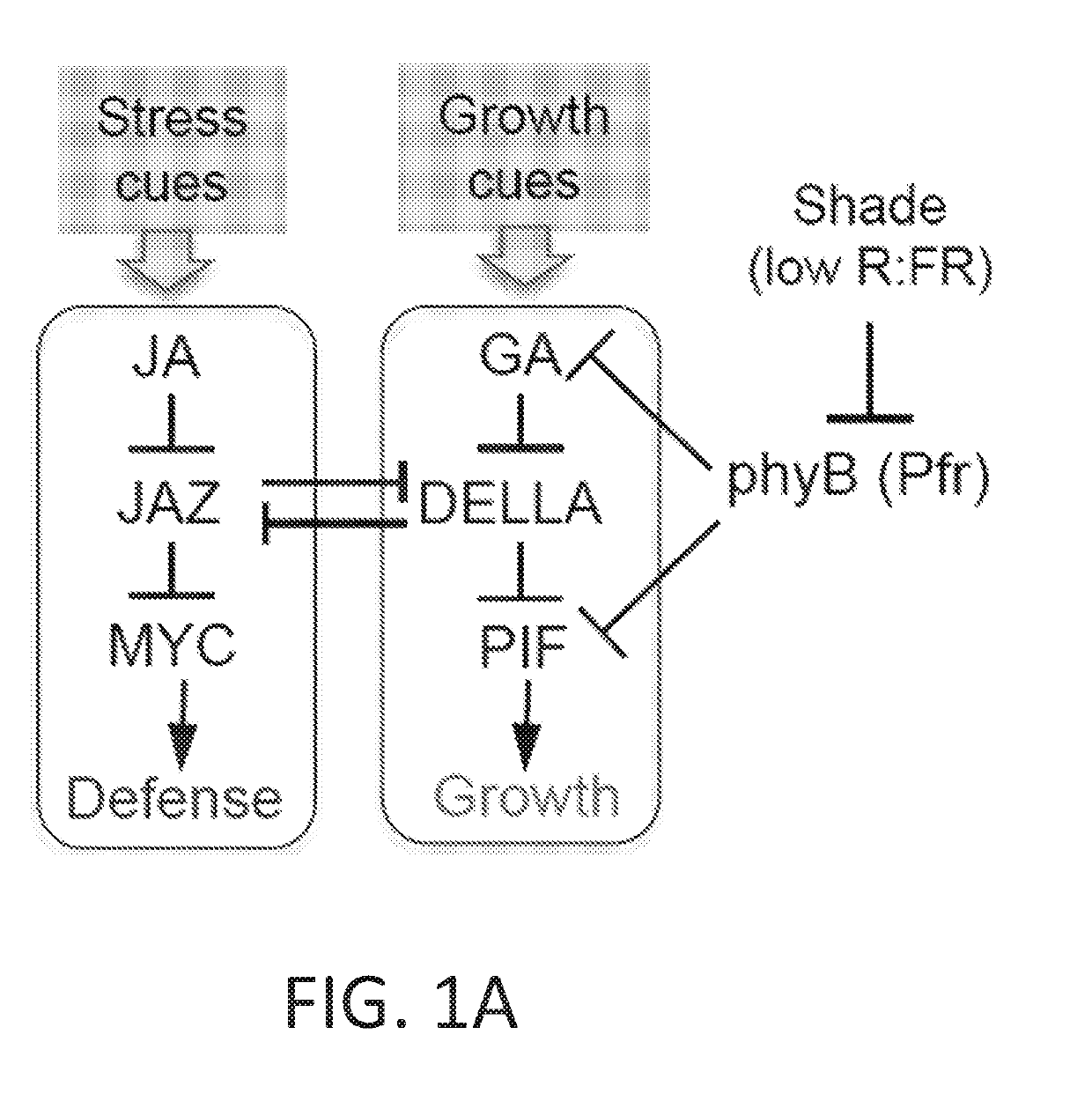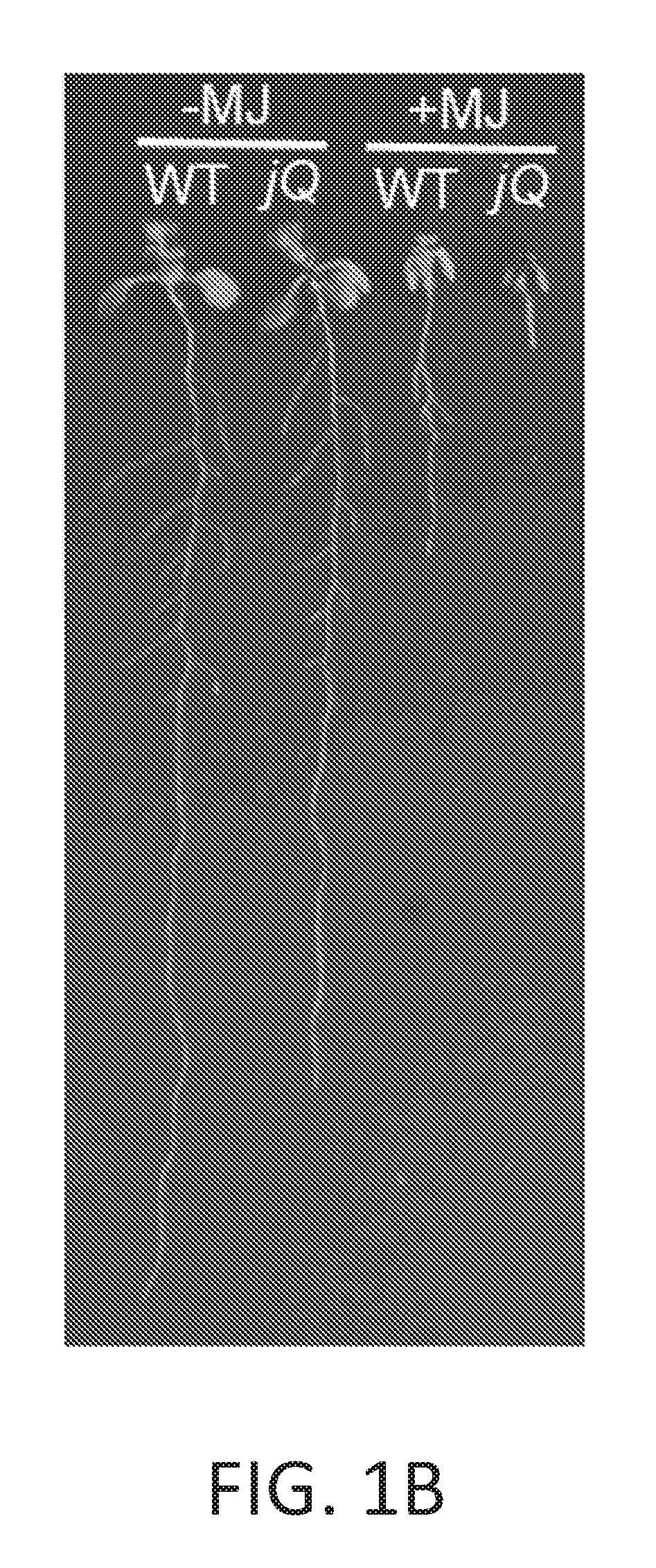Transcription factors to improve resistance to environmental stress in plants
a transcription factor and environmental stress technology, applied in the field of transcription factors to improve the resistance to environmental stress in plants, can solve the problems of reducing overall biomass yield, attenuating defense, and often suppressing growth of defense investments
- Summary
- Abstract
- Description
- Claims
- Application Information
AI Technical Summary
Benefits of technology
Problems solved by technology
Method used
Image
Examples
example 1
and Methods
[0234]This Example describes some of the material and methods employed in the development of the invention.
[0235]Plant Material and Growth Conditions.
[0236]Arabidopsis thaliana Columbia ecotype (Col-0) was used as a wild-type (WT) parent for all experiments. Soil-grown plants were maintained at 20° C. (±1° C.) with 16 h light at a light intensity of 120 μE m−2 s−1 and 8 h dark unless otherwise noted. For the first 10 days after seed sowing, trays containing potted plants were covered with a transparent plastic dome to increase humidity. For experiments involving growth of seedlings on agar plates, seeds were surface sterilized for 15 min in a solution containing 50% (v / v) bleach and 0.1% (v / v) Triton X-100, washed 10 times with sterile water and then stratified in dark at 4° C. for 2 days. Seeds were then sown on 0.7% (w / v) agar media containing half-strength Murashige and Skoog (MS; Caisson Labs) salts supplemented with 0.8% (w / v) sucrose.
[0237]Transfer DNA (T-DNA) inser...
example 2
ith Enhanced Jasmonate (JA)-Regulated Defense Against Insects
[0271]A genetic screen was performed to identify mutants of Arabidopsis that display enhanced jasmonate (JA)-regulated defense against insect herbivory without an associated reduction in leaf growth. This screen leveraged a signaling model predicting that removal of JAZ repressor proteins would constitutively activate defense and inhibit growth (FIG. 1A). A mutant plant line (jaz quintuple or jazQ) was developed with T-DNA insertion mutations in five (JAZ1 / 3 / 4 / 9 / 10) of the 13 Arabidopsis JAZ genes (FIG. 1G). These JAZs were selected on the basis of their phylogenetic relationship, their demonstrated role in inhibiting MYC transcription factors, and their capacity to interact with DELLA proteins that antagonistically link JA signaling to gibberellic acid (GA)-mediated growth responses (FIG. 1A).
[0272]Root growth assays showed that mutant jazQ seedlings have both an increased sensitivity to exogenous JA and a constitutive sh...
example 3
r Mutants with Enhanced Jasmonate (JA)-Regulated Defense Against Insects without Reduced Leaf Growth
[0273]An ethyl methanesulfonate (EMS)-mutagenized population of jazQ was visually screened for mutants with increased rosette size and persistence of elevated leafanthocyanin content. Among several suppressor of jazQ (sjq) mutants identified, one line (sjq11) showed a particularly striking leaf growth pattern that was heritable in the M3 generation (FIG. 2A). Importantly, bioassays performed with T. ni larvae showed that sjq11 plants also maintained heightened defenses (FIG. 2B). Characterization of sjq11 plants revealed phenotypes similar to those described for phytochrome B (phyB) photoreceptor mutants, including early flowering time, as well as elongated hypocotyls and petioles under continuous white light. Genetic allelism tests and DNA sequencing confirmed that sjq11 harbors a null mutation in the PHYB gene (FIG. 2G). To eliminate the possibility that additional EMS mutations con...
PUM
| Property | Measurement | Unit |
|---|---|---|
| Fraction | aaaaa | aaaaa |
| Fraction | aaaaa | aaaaa |
| Fraction | aaaaa | aaaaa |
Abstract
Description
Claims
Application Information
 Login to View More
Login to View More - R&D
- Intellectual Property
- Life Sciences
- Materials
- Tech Scout
- Unparalleled Data Quality
- Higher Quality Content
- 60% Fewer Hallucinations
Browse by: Latest US Patents, China's latest patents, Technical Efficacy Thesaurus, Application Domain, Technology Topic, Popular Technical Reports.
© 2025 PatSnap. All rights reserved.Legal|Privacy policy|Modern Slavery Act Transparency Statement|Sitemap|About US| Contact US: help@patsnap.com



